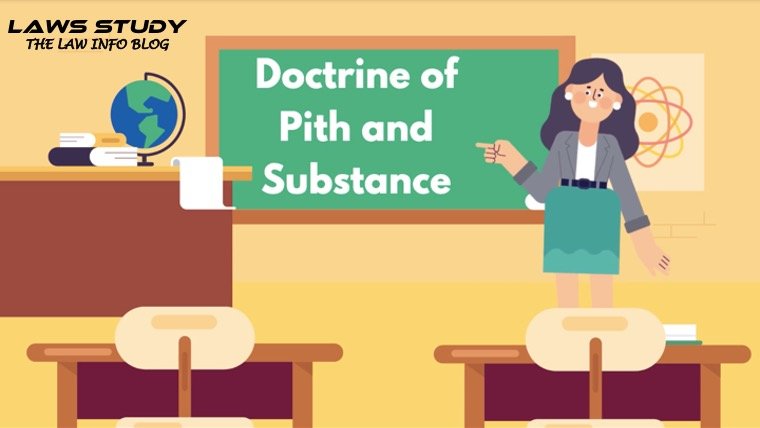Introduction of the Doctrine of Pith and Substance: – As per the Principle of Pith and Substance, whereas if the substance of legislation falls within a Legislature’s legitimate power, the legislation cannot become invalid merely because it impliedly directly affects an issue outside its officially approved sphere.
The phrase “true nature & character” translates as “Pith and Substance.” This doctrine is concerned with the infringement of a Federal State’s legislative powers as laid out in the constitution. The Court uses it to determine whether the alleged encroachment is simply irrelevant or substantial.
When it comes to the variety and complexity of various legislation, no amount of caution in articulating the distribution of authorities in a Federal structure will preclude real overlapping. The different aspects of life in society are not sufficiently confined from each other to make it possible for the separation of powers to be applied mechanically.
Originating in Canada
The doctrine was asserted in Canada in the case of Russel v. The Queen whenever a case of infringements by one senate on that of another that was made, the real nature & character of the statutory provisions in the specific instance under conversation must always be determined in order to ascertain the class particular subject with which it actually applies.
As per the Disciplinary Committee in Attorney General for Alberta v. Attorney General of Canada, when legislation is not competent, such as when it concerns an entry on the Federal Legislature List but is implemented by a provincial legislature, the issue of “occupied field,” that is, whether the federal legislature has legislated on it, is insignificant.
Whether or not the region is occupied, the provincial legislation will be rendered ineffective. The rule of ultra vires is the principle of pith & substance, and in this case, the comparison between its operation as well as the impact of the doctrine of “occupied field” was highlighted.
Is it important in terms of Fundamental Rights?
The courts have repudiated the pith & substance principle in the frame of reference of fundamental rights, & infringements of fundamental rights will be based on the “specific & irrecoverable” impact of an act provision. The evaluation of the pith & substance of the subject matter.
As well as the straightforward or largely irrelevant impact of the legislation, is significant to questions of legislative authority, but it is irrelevant to questions of fundamental rights infringement. The true litmus test in such cases is whether the disputed action has the effect of eliminating or restricting fundamental rights.
significance of Article 246 of Indian Constitution in relation to the Doctrine
It is necessary to examine Article 246 of the Indian Constitution in order to obtain a good understanding of the doctrine of Pith and Substance. Article 246 refers to the Union, State, & Concurrent lists, which are listed in the Constitution’s Seventh Schedule. Given the Indian Constitution’s federal nature, one of its most important features is the division of authority between the Union and state governments, which is stated in the Seventh Schedule, which includes: –
- List I– Union List (Parliamentary Legislation)
- List II– State List (State Legislation)
- List III– Concurrent List (Parliament and State Legislation)
The constitution’s framers created these three divisions. The Union List principally contains matters that are of national importance, necessitating the intervention of the Union government and enabling them the authority to legislate on these issues. Furthermore, the State list includes issues that are of local or state importance, therefore only state governments are needed to express an interest in them.
Finally, the concurrent list includes subjects that appear to be of common concern to both the federal and state governments, with both the state and federal governments having the authority to legislate on these issues.
Characteristics of Doctrine
This theory is invoked when the subject matter of two lists appears to be at odds.
- If every legislation is declared unconstitutional because it infringes on the rights of others, the legislature’s powers will be severely limited.
- The doctrine extracts the true nature and character of the matter in order to divide it into its appropriate list.
Historical Landmark Judgement
In the landmark judgment of Bombay vs. F.N.Balsara, the state’s liquor laws were questioned. on the grounds that it unintentionally infringed on the export and import of liquor across customs boundaries, which was considered as a central subject.
It was believed that prohibiting the purchase, use, possession, and sale of liquor would gradually reduce its import. As a result, the court upheld the aforementioned act as valid because the pith and substance of the act fell under the state list rather than the union list, despite the fact that the act incidentally infringed on the union powers of the legislation.
The importance of the Bombay money lenders act was challenged in another case, Prafulla Kumar versus Bank of Commerce, with the basic reason being that promissory notes, which were the responsibility of the central subject, were not part of the state matter.
The act, according to the Privy Council, is a statute that regulates money lending and money lenders, and it clearly falls within a state list issue. It was also stated that the act was valid even though it infringed on the matter of promissory note, which was a key subject, and therefore affirmed the ideology of pith & substance.
S.C declared in the case of Assn. of Natural Gas v UOI that if there is an irreparable dispute between the two legislations, the Central state law would prevail. However, before determining state legislation to be ultra vires, every effort should be made to resolve the dispute.
Conclusion
The concept of pith and substance is a term that relates to “the true essence and fundamental of any initial implementation,” as defined by the Canadian constitution. This principle has been used to ascertain the legislature’s basic competence to implement legislation under Article 246 of the constitution on the various subject items listed in the three lists of the seventh schedule, which are responsible for distinguishing between both the power acquired by the state and central legislative bodies to enact legislation about certain subject matters.
This ideology has been used to resolve issues arising from repugnancy caused by inconsistency in the laws enacted by the parliament and state legislatures under Article 254; thus, if there is any dispute between the three lists, list l (union list) would always take precedence over the other lists. It can also be used to examine the accuracy of implementation; the legislation would be declared valid if the encroachment caused is incidental or ancillary, but if it turns out to be significant, the implementation would’ve been declared invalid.

























